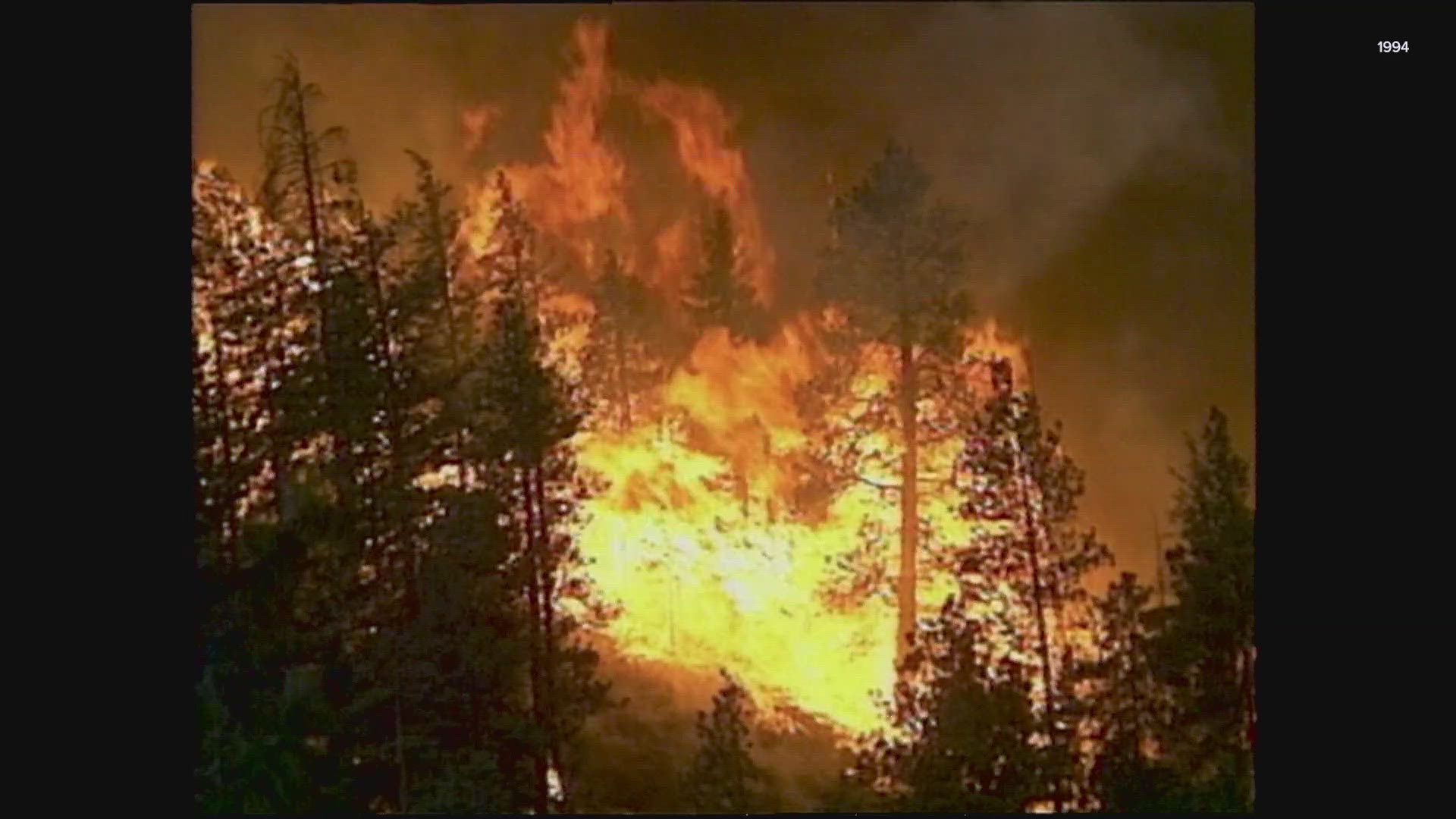LEAVENWORTH, Wash. —
This year marks 30 years since multiple wildfires ravaged across Washington state, destroying dozens of homes and forcing evacuations across the state. Now, in that same area, current residents are battling their own fight against fires.
The year 1994 started with major drought. After a hot and dry year, conditions during the summer of 1994 were a recipe for disaster. By the end of July, multiple fires had started back-to-back, both from lightning and people, including the Tyee Fire, the Hatchery Creek Fire and the Rat Creek Fire.
The iconic tourist town of Leavenworth was at the epicenter of the fires and was evacuated.
“Everybody was gone; it was a ghost town,” remembered Kelly O’Brien, who is now the fire chief at Chelan County Fire District #3.
In 1994, he had just become one of two fulltime firefighters with the district.
“I got thrown into a situation that was pretty tough for a 24-year-old just starting their fire career,” he recalled.
He said it was all hands on deck as surrounding agencies jumped in to battle the fires that were growing in the tough conditions.
“The fire itself was actually jumping in front of itself because of the wind so you’re getting these embers blowing across the mountainside... and it would start a spot fire and that spot fire would blow up and start another one,” O’Brien said.
Now, 30 years later, he said lessons he learned then are still in the back of his mind.
“The impact it had to me was really what fire can do because I had not seen that ever before in my career,” said O’Brien.
He pointed out that one of the biggest lessons learned for both his community and his crews was preparedness. Not only has he equipped his department with vehicles that can be used in different types of terrain, but he works to send his younger crews to help battle major wildfires in other areas to get hands-on experience.
“It’s important to take the lessons that I learned personally and apply it to the 24-year-old I just hired and say let’s go get you some experience before you get thrown in – we're still a small agency – so let’s go get you some experience in this state or other places so that when this does happen again, because it will, you have the capability and the instincts to handle it,” he said.
O’Brien also pointed out the preparedness lesson has carried into residents in the area.
“Our community has become more fire aware than they were in ‘94,” he said.
One of those residents is Bob Johnson, who had just started building a home outside of Leavenworth when the fires started in 1994.
"I get a call from a neighbor up the road and in the background it sounds like the Vietnam War with airplanes and helicopters,” he remembered.
Thankfully, Johnson's home survived, but he also still holds lessons learned 30 years ago into how he protects his property today. He hires a private crew to cut back the brush on his land so a fire won’t spread as easily, but also strives to leave enough greenery for wildlife to thrive.
“I'm rooting for wildlife and nature, so this is my team,” he said, gesturing to the nature around him.
Johnson said the labor and work isn’t cheap, but it’s worth it. He estimates that county and state money pays for about 30% of the work, but he pays the rest out of pocket.
This work is even more important for him, though, because of how fire response is set up in his area.
He lives in a part of the county that could have delayed fire response if help is needed. The closest fire agency is O’Brien’s district #3 station, which sits just a few miles away, but Johnson’s neighborhood doesn’t fall under this territory.
“Part of the reason it’s outside the fire district is because we can’t access that area year-round. We’re not just a wildland agency, we fight fires in the winter and I can’t get up the road,” said O’Brien, referencing the snow that makes the steep hills up to the neighborhood impassable.
Because of this, Johnson’s neighborhood falls under the state’s Department of Natural Resources (DNR) jurisdiction.
But DNR doesn’t have any firefighting vehicles on the ground nearby. If a fire should start in Johnson’s area, the closest fire response would be from an aerial response, flying in from Wenatchee.
And on top of that, DNR would only respond if it was a wildfire, not a structure fire.
“DNR - in their own structure policies - will tell you they don’t fight structure fires, they don’t. They’re not set up to do that. They're there for the wildland component. We’re there for the structure protection. So those homes, they’re basically if we’re available, we’re going, but legally I have to protect my community first who are paying the taxes to support the organization,” explained O’Brien.
It's a complicated setup, so these efforts from homeowners to prevent fire in the first place are even more important.
“Chelan 3 can’t do all the fuel reduction themselves. Forest service can’t do it all. DNR can’t do it all. But when the private citizens start doing it themselves, now you have an opportunity to have a big impact on the fuels surrounding the homes,” said O’Brien.
Johnson is glad to help, remembering the impacts of the ‘94 fires and hoping that never happens again.
“Everybody loves their homes, whether they live in the city or the suburbs or the woods, and the idea of it getting taken away so quickly, so unexpectedly and with nothing to do on your own to prevent it, is a shocking reality that we all have to absorb. But up here it seems to be a little more poignant because we live with that known risk every day because we are surrounded by beautiful things that are fuel,” said Johnson.

